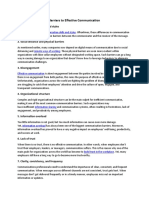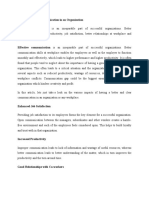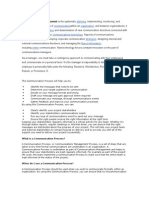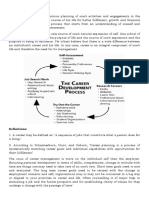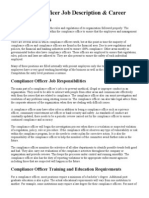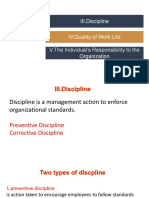Communication Problems in Organizations
“We have a communication problem.” How many times have you heard that as an explanation for project
failures, disgruntled employees, or a lack of teamwork in organizations? Aside from the dramatic cases, such
as a nurse not telling a doctor that he is about to operate on the wrong leg or a co-pilot not telling the pilot
that another plane is on the same landing approach, we rarely know what is meant by “communication
problem.” Several colleagues and I decided to find out. Leslie Stambaugh, Jim Stilwell, and I asked 15
organization leaders about the communication challenges they face in their organizations. An analysis of
their responses identified nine major categories:
1. Not All Employees Being Kept Informed
The assumption is that the usual modes of communication will send important information to everyone who
needs to know and that everyone will receive this information. However, in many organizations, the
information doesn’t reach people who are not using those methods of communication on a regular basis
(e.g., email that isn’t read by front-line workers).
2. Employees Not Receiving Consistent Messages from Management
Different supervisors are sending different, sometimes conflicting, messages about priorities. This causes
confusion and distrust among employees.
3. Employees Not Receiving Timely Messages
Information is not getting to employees when and where they need it. Without vital information at the right
time and in the right place, the decision-making process slows and projects are not completed on time or in
the best way.
4. The Right Information is Not Being Sent to the Right People
Critical information (e.g., market data) is not being shared among key stakeholders. Top management is not
engaging employees who have most of the customer contact in the important decisions of the organization.
Employees are not getting important information to management.
5. Expectations are Not Clear
Top leaders do not discuss expectations with mid-level managers. Therefore, they do not have the same
expectations nor do they agree on how to reach strategic goals. Because of this, employees do not have clear
goals and benchmarks to guide their progress.
6. Plan for the Future is Not Known
Leaders do not discuss their vision for the future of the organization with employees. There is no sense of a
shared direction toward which everyone is striving. This does not inspire employees to do their best work.
7. Functional Areas Not Collaborating
Departments/units do not share the information that could help all departments/units achieve common goals.
They are competitive rather than collaborative. This limits the capability of the organization as a whole.
8. Employees Not Open with Each Other
Employees do not share information with each other. They do not trust each other. This compromises the
productivity of teams, departments/units, and the organization.
9. Communication Hampered by Distance Between Units
Departments/units that are in different locations do not communicate as much and as often as those in close
proximity. The distance makes face-to-face meetings harder to arrange and collaboration takes more time.
Even in this age of email, cell phones, text messaging, and Web conferencing, critical communication
among leaders, between management and employees, and between departments/units, still does not happen
as much and as often as needed.
� Basics in Internal Organizational Communications
Common Causes of Problems in Internal Communications
1. If I know it, then everyone must know it.
Perhaps the most common communications problem is managements' (leaders' and managers')
assumption that because they are aware of some piece of information, than everyone else is, too.
Usually staffs aren’t aware unless management makes a deliberate attempt to carefully convey
information.
2. We hate bureaucracy -- we're "lean and mean."
When organizations are just getting started, their leaders can often prize themselves on not being
burdened with what seems as bureaucratic overhead, that is, as extensive written policies and
procedures. Writing something down can be seen as a sign of bureaucracy and to be avoided. As the
organization grows, it needs more communications and feedback to remain healthy, but this
communication isn't valued. As a result, increasing confusion ensues -- unless management matures
and realizes the need for increased, reliable communications.
3. I told everyone, or some people, or ...?
Another frequent problem is managements' not really valuing communications or assuming that it just
happens. So they're not aware of what they told to whom -- even when they intended for everyone to
know the information.
4. Did you hear what I meant for you to hear?
With today's increasingly diverse workforce, it's easy to believe you've conveyed information to
someone, but you aren't aware that they interpreted you differently than you intended. Unfortunately,
you won't be aware of this problem until a major problem or issue arises out of the confusion.
5. Our problems are too big to have to listen to each other!
Particularly when personnel are tired or under stress, it's easy to do what's urgent rather than what's
important. So people misunderstand others' points or understand their intentions. This problem usually
gets discovered too late, too.
6. So what's to talk about?
Lastly, communications problems can arise when inexperienced management interprets its job to be
solving problems and if they're aren't any problems/crises, then there's nothing that needs to be
communicated.
7. There's data and there's information.
As organizations grow, their management tends to focus on matters of efficiency. They often generate
systems that produce substantial amount of data -- raw information that doesn't seem to really be
important.
7. If I need your opinion, I'll tell it to you.
Lastly, communications problems can arise when management simply sees no value whatsoever in
communicating with subordinates, believing subordinates should shut up and do their jobs.
Key Principles to Effective Internal Organizational Communications
1. Unless management comprehends and fully supports the premise that organizations must have high
degrees of communications (like people needing lots of water), the organization will remain stilted. Too
often, management learns the need for communication by having to respond to the lack of it.
2. Effective internal communications start with effective skills in communications, including basic skills
in listening, speaking, questioning and sharing feedback (see Communications Skills.
These can developed with some concerted review and practice. Perhaps the most important outcome
from these skills is conveying that you value hearing from others and their hearing from you.
3. Sound meeting management skills go a long way toward ensuring effective communications, too. (
4. A key ingredient to developing effective communications in any organization is each person taking
responsibility to assert when they don't understand a communication or to suggest when and how
someone could communicate more effectively.
�Basic Structures/Policies to Support Effective Internal Communications
This communication can be looked at as communications downward and upward.
Downward Communications:
1. Ensure every employee receives a copy of the strategic plan, which includes the organization's
mission, vision, values statement, strategic goals and strategies about how those goals will be reached.
2. Ensure every employee receives an employee handbook that contains all up-to-date personnel
policies.
3. Develop a basic set of procedures for how routine tasks are conducted and include them in standard
operating manual.
4. Ensure every employee has a copy of their job description and the organization chart.
5. Regularly hold management meetings (at least every two weeks), even if there's nothing pressing to
report. If you hold meetings only when you believe there's something to report, then communications
will occur only when you have something to say -- communications will be one way and the
organization will suffer. Have meetings anyway, if only to establish and affirm the communication that
things are of a status that there's not immediate problems.
6. Hold full staff meetings every month to report how the organization is doing, major
accomplishments, concerns, announcements about staff, etc.
7. Leaders and managers should have face-to-face contact with employees at least once a week. Even
if the organization is over 20 employees (large for a nonprofit), management should stroll by once in a
while.
8. Regularly hold meetings to celebrate major accomplishments. This helps employees perceive what's
important, gives them a sense of direction and fulfillment, and let's them know that leadership is on
top of things.
9. Ensure all employees receive yearly performance reviews, including their goals for the year, updated
job descriptions, accomplishments, needs for improvement, and plans to help the employee accomplish
the improvements. If the nonprofit has sufficient resources (a realistic concern), develop a career plan
with the employee, too.
Upward Communications:
1. Ensure all employees give regular status reports to their supervisors. Include a section for what they
did last week, will do next week and any actions/issues to address.
2. Ensure all supervisors meet one-on-one at least once a month with their employees to discuss how
its' going, hear any current concerns from the employee, etc. Even if the meeting is chit-chat, it
cultivates an important relationship between supervisor and employee.
3. Use management and staff meetings to solicit feedback. Ask how it's going. Do a round table
approach to hear from each person.
4. Act on feedback from others. Write it down. Get back to it -- if only to say you can't do anything
about the reported problem or suggestion, etc.
5. Respect the "grapevine." It's probably one of the most prevalent and reliable forms of
communications. Major "movements" in the organization usually first appear when employees feel it
safe to venture their feelings or opinions to peers.
Supervisor and Employee Communications
Supervision is often considered to include designing the job, hiring someone to fill the job, training
them, delegating to them, guiding them via performance reviews, helping them develop their career,
noting performance issues, and firing them, if needed. Obviously small nonprofits may not be able to
afford full attention to all of these activities.
However, there are several basic and regular activities which provide a solid foundation for effective
supervision. These basics ensure that everyone is working together -- as important, that staff feel they
are working together -- towards a common cause.
�Ironically, these basics are usually the first activities that stop when an organization is in a crisis.
Consequently, an organization development specialist, when "diagnosing" an organization, often first
looks to see if these basics are underway. The following activities should be conducted by the new
employer's supervisor.
1. Have all employees provide weekly written status reports to their supervisors.
Include what tasks were done last week, what tasks are planned next week, any pending issues and
date the report. These reports may seem a tedious task, but they're precious in ensuring that
employee and their supervisor have mutual understanding of what is going on, and the reports come in
very handy for planning purposes. They also make otherwise harried staff and managers stand back
and reflect on what they're doing.
2. Hold monthly meetings with all staff together
- Review the overall condition of the organization and review recent successes. Consider conducting "in
service" training where employees take turns describing their roles to the rest of the staff. For clarity,
focus and morale, be sure to use agendas and ensure follow-up minutes. Consider bringing in a client
to tell their story of how the organization helped them. These meetings go a long way toward building
a feeling of teamwork among staff. (See Guidelines for Meeting Management
(http://www.managementhelp.org/misc/mtgmgmnt.htm).
3. Hold weekly or biweekly meetings with all staff together if the organization is small (e.g.,
under 10 people); otherwise, with all managers together.
Have these meetings even if there is not a specific problem to solve -- just make them shorter.
(Holding meetings only when there are problems to solve cultivates a crisis-oriented environment
where managers believe their only job is to solve problems.) Use these meetings for each person to
briefly give an overview of what they are doing that week. Facilitate the meetings to support exchange
of ideas and questions. Again, for clarity, focus and morale, be sure to use agendas, take minutes and
ensure follow-up minutes. Have each person bring their calendar to ensure scheduling of future
meetings accommodates each person's calendar.
4. Have supervisors meet with their direct reports in one-on-one meetings every month -
This ultimately produces more efficient time management and supervision. Review overall status of
work activities, hear how it's going with both the supervisor and the employee, exchange feedback and
questions about current programs and services, and discuss career planning, etc. Consider these
meetings as interim meetings between the more formal, yearly performance review meetings.
Develop a Basic Communications Plan
Whether planning your internal or external communications efforts, it helps a great deal to develop a
communications plan, either informally or formally. For example, consider:
1. What key messages do you want to convey?
2. To what key stakeholders do you want to convey the key messages (e.g., consider clients, funders,
community leaders, service providers, etc.)?
3. What's the best approach to reach each key stakeholder, including who/how should the message be
conveyed?
4. How will you know if you're reaching these stakeholders or not?

































